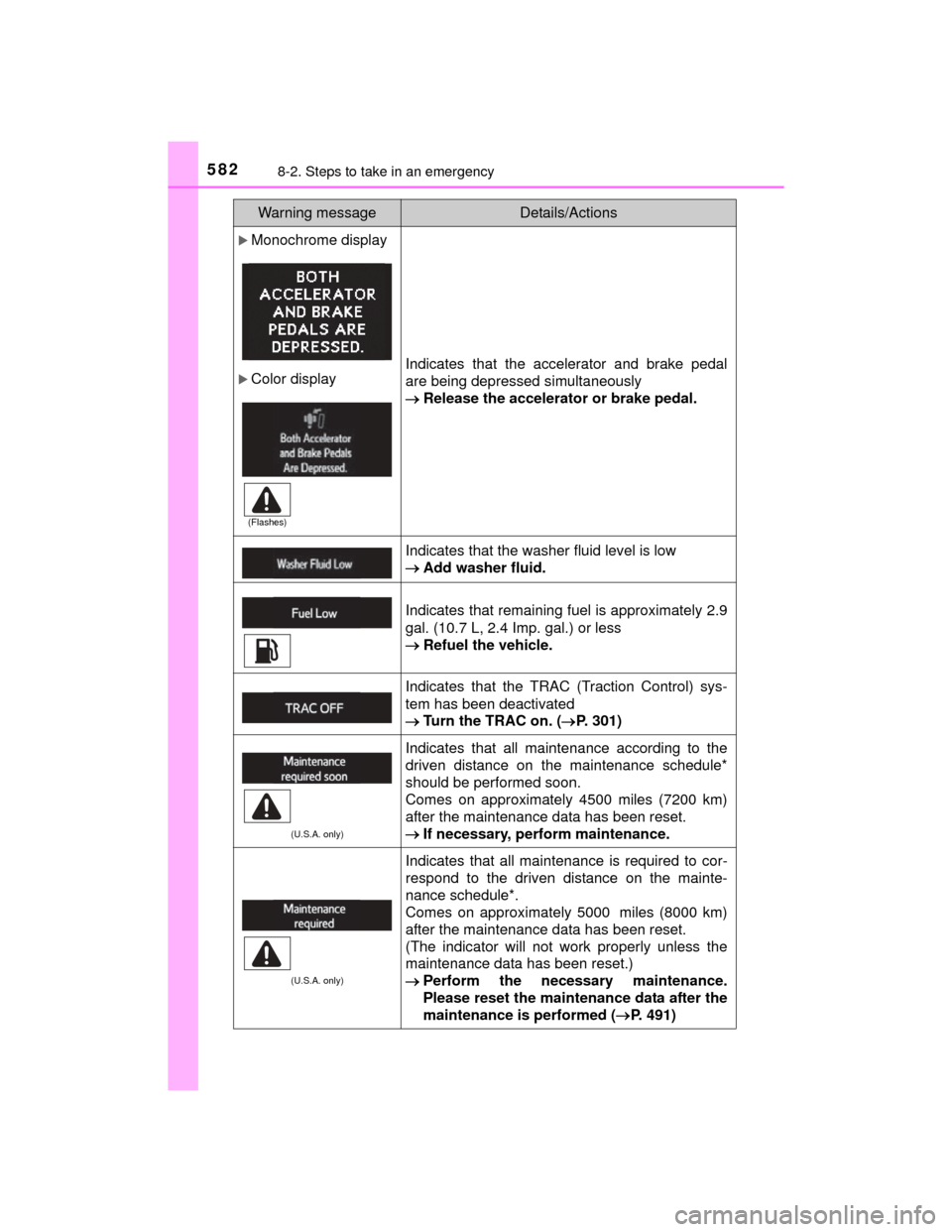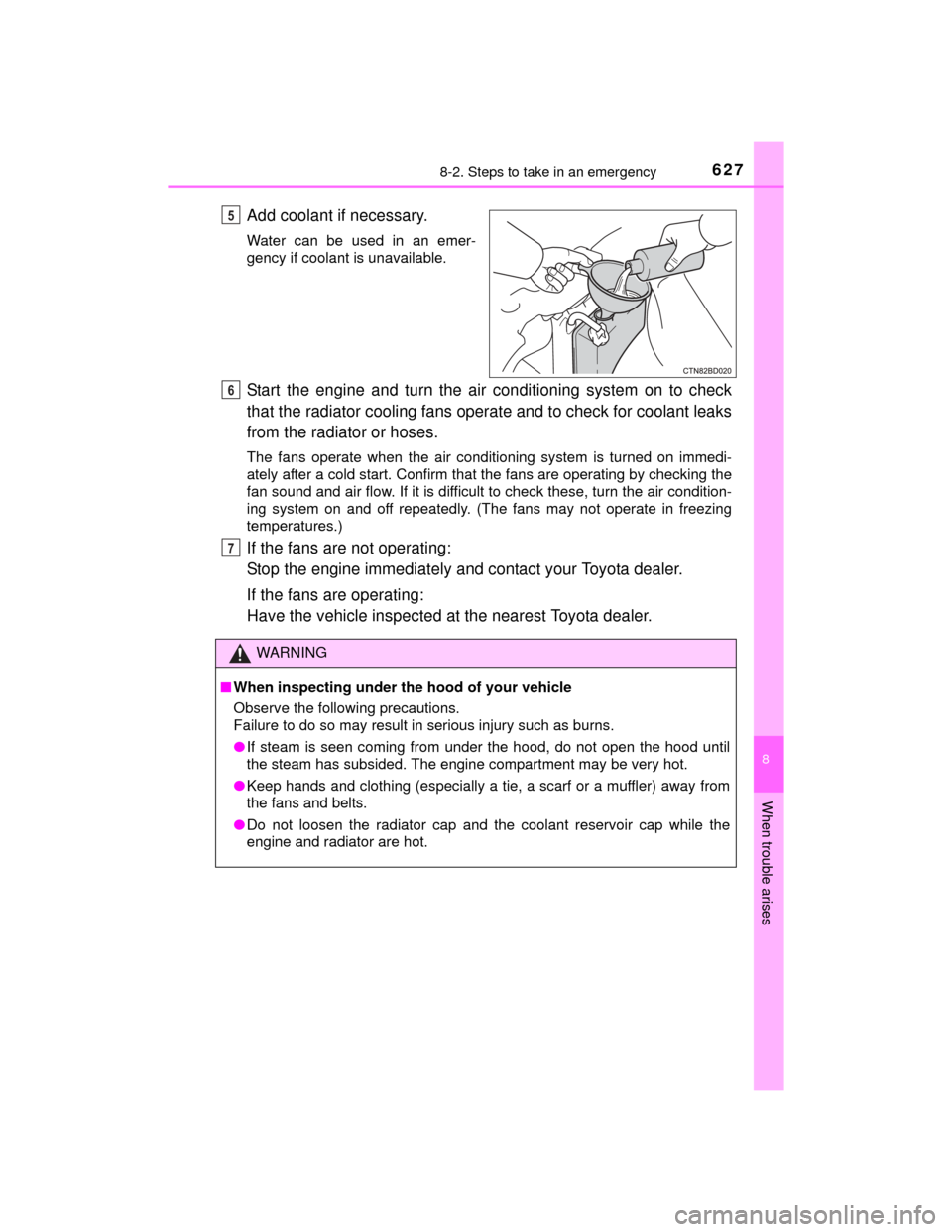2014 TOYOTA HIGHLANDER ESP
[x] Cancel search: ESPPage 570 of 712

5708-2. Steps to take in an emergency
HIGHLANDER_U (OM48A12U)
WARNING
■Maintenance of the tires
Each tire, including the spare (if provided), should be checked monthly
when cold and inflated to the inflation pressure recommended by the
vehicle manufacturer on the vehicle placard or tire inflation pressure
label (tire and load information label). (If your vehicle has tires of a dif-
ferent size than the size indicated on the vehicle placard or tire inflation
pressure label [tire and load information label], you should determine
the proper tire inflation pressure for those tires.)
As an added safety feature, your vehicle has been equipped with a tire
pressure monitoring system (TPMS-tire pressure warning system) that
illuminates a low tire pressure telltale (tire pressure warning light) when
one or more of your tires is significantly under-inflated. Accordingly,
when the low tire pressure telltale (tire pressure warning light) illumi-
nates, you should stop and check your tires as soon as possible, and
inflate them to the proper pressure. Driving on a significantly under-
inflated tire causes the tire to overheat and can lead to tire failure.
Under-inflation also reduces fuel efficiency and tire tread life, and may
affect the vehicle’s handling and stopping ability.
Please note that the TPMS (tire pressure warning system) is not a sub-
stitute for proper tire maintenance, and it is the driver’s responsibility to
maintain correct tire pressure, even if under-inflation has not reached
the level to trigger illumination of the TPMS low tire pressure telltale (tire
pressure warning light).
Your vehicle has also been equipped with a TPMS (tire pressure warn-
ing system) malfunction indicator to indicate when the system is not
operating properly. The TPMS (tire pressure warning system) malfunc-
tion indicator is combined with the low tire pressure telltale (tire pressure
warning light). When the system detects a malfunction, the telltale will
flash for approximately one minute and then remain continuously illumi-
nated. This sequence will continue upon subsequent vehicle start-ups
as long as the malfunction exists. When the malfunction indicator is illu-
minated, the system may not be able to detect or signal low tire pres-
sure as intended.
TPMS (tire pressure warning system) malfunctions may occur for a vari-
ety of reasons, including the installation of replacement or alternate tires
or wheels on the vehicle that prevent the TPMS (tire pressure warning
system) from functioning properly. Always check the TPMS (tire pres-
sure warning system) malfunction telltale after replacing one or more
tires or wheels on your vehicle to ensure that the replacement or alter-
nate tires and wheels allow the TPMS (tire pressure warning system) to
continue to function properly.
Page 582 of 712

5828-2. Steps to take in an emergency
HIGHLANDER_U (OM48A12U)
Monochrome display
Color displayIndicates that the accelerator and brake pedal
are being depressed simultaneously
Release the accelerator or brake pedal.
Indicates that the washer fluid level is low
Add washer fluid.
Indicates that remaining fuel is approximately 2.9
gal. (10.7 L, 2.4 Imp. gal.) or less
Refuel the vehicle.
Indicates that the TRAC (Traction Control) sys-
tem has been deactivated
Turn the TRAC on. ( P. 301)
(U.S.A. only)
Indicates that all maintenance according to the
driven distance on the maintenance schedule*
should be performed soon.
Comes on approximately 4500 miles (7200 km)
after the maintenance data has been reset.
If necessary, perform maintenance.
(U.S.A. only)
Indicates that all maintenance is required to cor-
respond to the driven distance on the mainte-
nance schedule*.
Comes on approximately 5000 miles (8000 km)
after the maintenance data has been reset.
(The indicator will not work properly unless the
maintenance data has been reset.)
Perform the necessary maintenance.
Please reset the maintenance data after the
maintenance is performed ( P. 491)
Warning messageDetails/Actions
(Flashes)
Page 624 of 712

6248-2. Steps to take in an emergency
HIGHLANDER_U (OM48A12U)
■Starting the engine when the battery is discharged
The engine cannot be started by push-starting.
■ To prevent battery discharge
●Turn off the headlights and the audio system while the engine is off.
● Turn off any unnecessary electrical components when the vehicle is running
at a low speed for an extended period, such as in heavy traffic.
■ When recharging or replacing the battery
●Vehicles with a smart key system: In some cases, it may not be possible to
unlock the doors using the smart key system when the battery is dis-
charged. Use the wireless remote control or the mechanical key to lock or
unlock the doors.
● Vehicles with a smart key system: The engine may not start on the first
attempt after the battery has recharged but will start normally after the sec-
ond attempt. This is not a malfunction.
● Vehicles with a smart key system: The engine switch mode is memorized by
the vehicle. When the battery is reconnected, the system will return to the
mode it was in before the battery was discharged. Before disconnecting the
battery, turn the engine switch off.
If you are unsure what mode the engine switch was in before the battery dis-
charged, be especially careful when reconnecting the battery.
● Vehicle with power back door: The power back door must be initialized.
(P. 672)
■ Charging the battery
The electricity stored in the battery will discharge gradually even when the
vehicle is not in use, due to natural discharge and the draining effects of cer-
tain electrical appliances. If the vehicle is left for a long time, the battery may
discharge, and the engine may be unable to start. (The battery recharges
automatically during driving.)
Page 627 of 712

6278-2. Steps to take in an emergency
8
When trouble arises
HIGHLANDER_U (OM48A12U)
Add coolant if necessary.
Water can be used in an emer-
gency if coolant is unavailable.
Start the engine and turn the air conditioning system on to check
that the radiator cooling fans operate and to check for coolant leaks
from the radiator or hoses.
The fans operate when the air conditioning system is turned on immedi-
ately after a cold start. Confirm that the fans are operating by checking the
fan sound and air flow. If it is difficult to check these, turn the air condition-
ing system on and off repeatedly. (The fans may not operate in freezing
temperatures.)
If the fans are not operating:
Stop the engine immediately and contact your Toyota dealer.
If the fans are operating:
Have the vehicle inspected at the nearest Toyota dealer.
5
WARNING
■When inspecting under the hood of your vehicle
Observe the following precautions.
Failure to do so may result in serious injury such as burns.
●If steam is seen coming from under the hood, do not open the hood until
the steam has subsided. The engine compartment may be very hot.
● Keep hands and clothing (especially a tie, a scarf or a muffler) away from
the fans and belts.
● Do not loosen the radiator cap and the coolant reservoir cap while the
engine and radiator are hot.
6
7
Page 655 of 712

6559-1. Specifications
9
Vehicle specifications
HIGHLANDER_U (OM48A12U)■
Temperature A, B, C
The temperature grades are A (the highest), B, and C, representing
the tire’s resistance to the generation of heat and its ability to dissi-
pate heat when tested under controlled conditions on a specified
indoor laboratory test wheel.
Sustained high temperature can cause the material of the tire to
degenerate and reduce tire life, and excessive temperature can lead
to sudden tire failure.
Grade C corresponds to a level of performance which all passenger
car tires must meet under the Federal Motor Vehicle Safety Stan-
dard No. 109.
Grades B and A represent higher levels of performance on the labo-
ratory test wheel than the minimum required by law.
Warning: The temperature grades of a tire assume that it is properly
inflated and not overloaded.
Excessive speed, underinflation, or excessive loading, either sepa-
rately or in combination, can cause heat buildup and possible tire
failure.
Page 681 of 712

681
HIGHLANDER_U (OM48A12U)
10
For owners
AVERTISSEMENT
■Précautions concernant les coussins gonflables SRS
Respectez les précautions suivantes concernant les coussins gonflables
SRS.
Autrement, des blessures graves, voire mortelles, pourraient s’ensuivre.
●Le conducteur et tous les passagers du véhicule doivent porter correcte-
ment leur ceinture de sécurité.
Les coussins gonflables SRS sont des dispositifs supplémentaires à utili-
ser avec les ceintures de sécurité.
● Le coussin gonflable SRS conducteur se déploie avec une violence consi-
dérable, qui peut causer des blessures graves, voire mortelles, si le con-
ducteur se trouve très près du coussin gonflable. La NHTSA (National
Highway Traffic Safety Ad ministration) conseille:
Sachant que la zone de danger pour le coussin gonflable conducteur se
trouve dans les premiers 2 à 3 in. (50 - 75 mm) de déploiement, vous pla-
cer à 10 in. (250 mm) de votre coussin gonflable conducteur vous garantit
une marge de sécurité suffisante. Cette distance est à mesurer entre le
centre du volant et le sternum. Si vous êtes assis à moins de 10 in. (250
mm), vous pouvez changer votre position de conduite de plusieurs
façons:
• Reculez votre siège le plus possible, de manière à pouvoir encore atteindre confortablement les pédales.
• Inclinez légèrement le dossier du siège. Bien que les véhicules puissent être différents les uns des autres, la
plupart des conducteurs peuvent s’asseoir à une distance de 10 in.
(250 mm), même avec le siège conducteur complètement avancé, sim-
plement en inclinant un peu le dossier de siège. Si vous avez des diffi-
cultés à voir la route après avoir incliné votre siège, utilisez un coussin
ferme et antidérapant pour vous rehausser ou remontez le siège si
votre véhicule est équipé de cette fonction.
• Si votre volant est réglable, inclinez-le vers le bas. Cela a pour effet d’orienter le coussin gonflable en direction de votre poitrine plutôt que
de votre tête et de votre cou.
Réglez votre siège selon les recommandations de la NHTSA ci-dessus,
tout en conservant le contrôle des pédales, du volant et la vue des com-
mandes du tableau de bord.
Page 685 of 712

685
HIGHLANDER_U (OM48A12U)
10
For owners
AVERTISSEMENT
■Précautions concernant les coussins gonflables SRS
●Si un cache en vinyle recouvre la partie où le coussin gonflable de genoux
pour conducteur SRS se déploie, veillez à l'enlever.
● N’utilisez aucun accessoire de siège qui couvrirait les zones de déploie-
ment des coussins gonflables latéraux SRS et du coussin gonflable
d'assise SRS, car il risquerait de gêner le déploiement des coussins gon-
flables. De tels accessoires peuvent empêcher les coussins gonflables
latéraux et le coussin gonflable d’assise de fonctionner correctement,
désactiver le dispositif ou entraîner le déploiement accidentel des cous-
sins gonflables latéraux et du coussin gonflable d’assise, entraînant la
mort ou des blessures graves.
● Ne faites pas subir de chocs ou de pressions excessives à la zone renfer-
mant les composants de coussin gonflable SRS.
En effet, cela pourrait entraîner un fonctionnement anormal des coussins
gonflables SRS.
● Ne touchez aucun composant du système immédiatement après le
déploiement (gonflage) des coussins gonflables SRS, car ils peuvent être
chauds.
● Si vous avez des difficultés à respirer après le déploiement des coussins
gonflables SRS, ouvrez une porte ou une vitre pour faire entrer de l’air
frais, ou bien descendez du véhicule si cela ne présente pas de danger.
Essuyez tout résidu dès que possible afin d’éviter d’éventuelles irritations
de la peau.
● Si les parties renfermant les coussins gonflables SRS, telles que la garni-
ture du volant et les garnitures de montants avant et arrière, sont abîmées
ou craquelées, faites-les remplacer par votre concessionnaire Toyota.
● Ne disposez rien sur le siège du passager avant, comme par exemple un
coussin. Cela aurait pour conséquence de répartir le poids du passager
sur toute la surface du siège, ce qui empêche le capteur de détecter cor-
rectement le poids du passager. Il en résulte que les coussins gonflables
avant SRS du passager avant risquent de ne pas se déployer en cas de
collision.